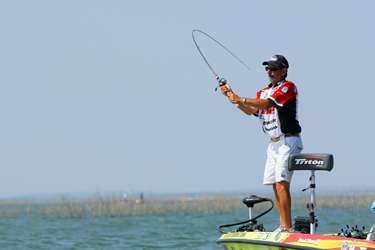
His distinct kneel-and-reel form gives away what Paul Elias is doing this time of year.
Despite the availability of longer rods, advancements in fishing lines and deeper diving crankbaits, Elias still kneels down on the deck of his boat and sticks his rod in the water as he did in 1982 when he won the Bassmaster Classic. Holding his rod with all but the handle and reel under the water forced his crankbait down to a submerged river bar that produced a winning weight of 32 pounds, 8 ounces.
“When you’re trying to get a bait down 18 to 20 feet, you just about have to kneel and reel if you want it down on the bottom for any amount of time,” he says.
Keeping his crankbait on the bottom is the key to deep cranking success. “I want my bait digging into the bottom almost all of the time,” Elias says. Long casts help Elias probe the bottom with his crankbait. “The longer the cast you can make, the deeper you can get the bait,” he says.
His favorite targets for deep cranking are shellbeds ranging from eight to 20 feet deep. The best beds are usually located along bars next to a creek or river channel. The Mississippi pro positions his boat where he can cast his crankbait about 25 yards past the shellbed so his lure can reach its maximum depth at the right spot. “It takes a while for your bait to get down deep,” he advises. “Your crankbait is usually at its deepest point when it’s about two-thirds of the way back to the boat.”
Elias usually fancasts the area until he catches a couple of fish. Then he directs the rest of his casts to the spot where he believes the bass are schooling. Deep cranking will produce some suspended fish, but the majority of Elias’ catches are bottom-huggers.
The former Classic champ triggers strikes by cranking his lure at a medium pace until it reaches its maximum depth, then he burns the lure to bang it into the bottom. He’ll also stop the bait frequently. A Mann’s 20+ crankbait is Elias’ choice for deep cranking throughout the summer.
His three favorite colors for fishing in clear, stained or murky water are a shad pattern, brown back/chartreuse belly and green back/chartreuse belly. “Even when the fish are feeding on shad, it seems like a bait with chartreuse in it gets more bites,” he says. The only modification he makes to his crankbait is to replace the original #2 hooks with #1 Gamakatsu trebles.
The six-time BASS winner casts his crankbaits farther and make them dive deeper with a 7-foot, 8-inch Pinnacle crankbait rod and Pinnacle baitcasting reel (5.1:1 gear ratio) spooled with 12-pound test Berkley 100% Fluorocarbon. Elias prefers the fluorocarbon line because it has greater sensitivity and sinks better than monofilament.
Deep cranking works best throughout the summer when bass tend to school. “When the fish are schooled it can take a reaction bait to get the fish excited and to start feeding,” says Elias. “When a crankbait comes running through a school of fish, it’s hard for them not to hit it. A lot of times you can catch a fish on a worm or jig but not really get the school fired up.” Working a big crankbait all day can be physically demanding, but Elias knows the rewards can be great when summer bass get excited.
The most common mistake he sees weekend anglers make is giving up on the technique too quickly. “They just get tired,” he says. Deep cranking works for Elias until about the full moon of September. That’s usually when the baitfish start their fall migration to the backs of the pockets and creeks and bass follow. Editor’s Note: If you have a story idea you would like to vote on for an upcoming poll, send your idea to john@jnoutdoors.com.





